Wednesday, November 23, 2005
The Tassie Echidna Superfecta
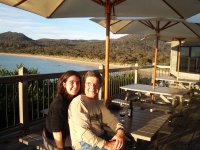 So, my folks and I traveled to the least populated state in Australia, the proud southern island of Tasmania. Tassie is a beautiful place, full of forests, both eucalyptus and rainforest, sheep, long white beaches, echidna, more sheep and more echidnas.
So, my folks and I traveled to the least populated state in Australia, the proud southern island of Tasmania. Tassie is a beautiful place, full of forests, both eucalyptus and rainforest, sheep, long white beaches, echidna, more sheep and more echidnas. 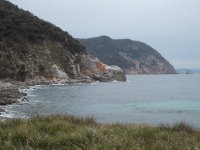 We arrived in Launceston, the second largest town in Tasmania with a population of about 100K. We stayed in a funky bed and breakfast place, and took a drive to Low Head, the northernmost point on the southern isle. A lovely spot, with an active lighthouse that offers overnight accommodation (if we had known!). For dinner we went to Fee and Me, the "best restaurant" in Tassie. It was good but not excellent, and not even the best food we had on our five night trip.
We arrived in Launceston, the second largest town in Tasmania with a population of about 100K. We stayed in a funky bed and breakfast place, and took a drive to Low Head, the northernmost point on the southern isle. A lovely spot, with an active lighthouse that offers overnight accommodation (if we had known!). For dinner we went to Fee and Me, the "best restaurant" in Tassie. It was good but not excellent, and not even the best food we had on our five night trip. 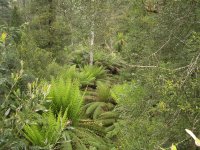 The next morning we drove over to the east coast of Tasmania through the mountains, covered in eucalyptus forest. The forests were beautiful and the east coast was lovely, with lots of white sand coves and inlets. That night we stayed in Freycinent National Park, home to famous Wineglass Bay. We had a wonderful dinner of seafood stew. We choose the national park because the abundance of critters, and we were smart in our decision, because on the walk back to our cabin after dinner we saw the friendly nocturnal quoll. A quoll (aside from a great Scrabble word) is a marsupial, possum-like creature. It was a friendly creature, a bit too friendly, as it keep walking towards us and freaked us out a bit.
The next morning we drove over to the east coast of Tasmania through the mountains, covered in eucalyptus forest. The forests were beautiful and the east coast was lovely, with lots of white sand coves and inlets. That night we stayed in Freycinent National Park, home to famous Wineglass Bay. We had a wonderful dinner of seafood stew. We choose the national park because the abundance of critters, and we were smart in our decision, because on the walk back to our cabin after dinner we saw the friendly nocturnal quoll. A quoll (aside from a great Scrabble word) is a marsupial, possum-like creature. It was a friendly creature, a bit too friendly, as it keep walking towards us and freaked us out a bit. We woke early the next day to look for kangaroos and wallabies. We don't really know what the difference is between roos and wallabies -- apparently the wallabies are smaller -- but it doesn't really matter since we saw several of roo-allabies in the bush. My dad even tracked one along the beach, but alas, his memory card was full so the photo was not captured.
We woke early the next day to look for kangaroos and wallabies. We don't really know what the difference is between roos and wallabies -- apparently the wallabies are smaller -- but it doesn't really matter since we saw several of roo-allabies in the bush. My dad even tracked one along the beach, but alas, his memory card was full so the photo was not captured.  Hobart was our home for the next three nights. We shopped at the Salamanca market, a decent but not excellent street market. We also visited Bruny Island, located off the coast about 50 kilometers south west of Hobart. A short 20 minute ferry ride separates the island from the mainland. Bruny consists of two parts, connected by a narrow isthmus about 200 meters across. We saw a penguin rookery (but the penguins were all out fishing), more beautiful coastlines, more sheep, a tasmanian devil (pictured), another lighthouse, and the highlight of the trip for me, the first of four echidna.
Hobart was our home for the next three nights. We shopped at the Salamanca market, a decent but not excellent street market. We also visited Bruny Island, located off the coast about 50 kilometers south west of Hobart. A short 20 minute ferry ride separates the island from the mainland. Bruny consists of two parts, connected by a narrow isthmus about 200 meters across. We saw a penguin rookery (but the penguins were all out fishing), more beautiful coastlines, more sheep, a tasmanian devil (pictured), another lighthouse, and the highlight of the trip for me, the first of four echidna. 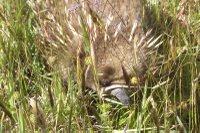 The echidna is a fascinating animal. It one of only two monotreme species remaining in the world (along with the platypus). The echidna lays eggs but provides milk to its young, and is thus a mammal. Echidnas resemble anteaters, but they have spines like a porcupine and are a bit furry as well. We came across the echidna meandering along the side of the road. We stopped the car, hopped out and Mr. Echidna just froze. To 'hide' from predators, echidnas try to dig into the ground. He got about a tenth of an inch into the ground. After about a minute, he got bored of us and started walking on.
The echidna is a fascinating animal. It one of only two monotreme species remaining in the world (along with the platypus). The echidna lays eggs but provides milk to its young, and is thus a mammal. Echidnas resemble anteaters, but they have spines like a porcupine and are a bit furry as well. We came across the echidna meandering along the side of the road. We stopped the car, hopped out and Mr. Echidna just froze. To 'hide' from predators, echidnas try to dig into the ground. He got about a tenth of an inch into the ground. After about a minute, he got bored of us and started walking on. 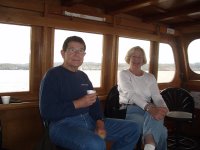 After Bruny Island, we did more exploring, including visiting the top of Mount Wellington, a 3000-ft. peak that overlooks Hobart and took a wonderful harbor cruise. Along the way, we spotted three more echidnas. To me, a perfect holiday!
After Bruny Island, we did more exploring, including visiting the top of Mount Wellington, a 3000-ft. peak that overlooks Hobart and took a wonderful harbor cruise. Along the way, we spotted three more echidnas. To me, a perfect holiday!

<< Home